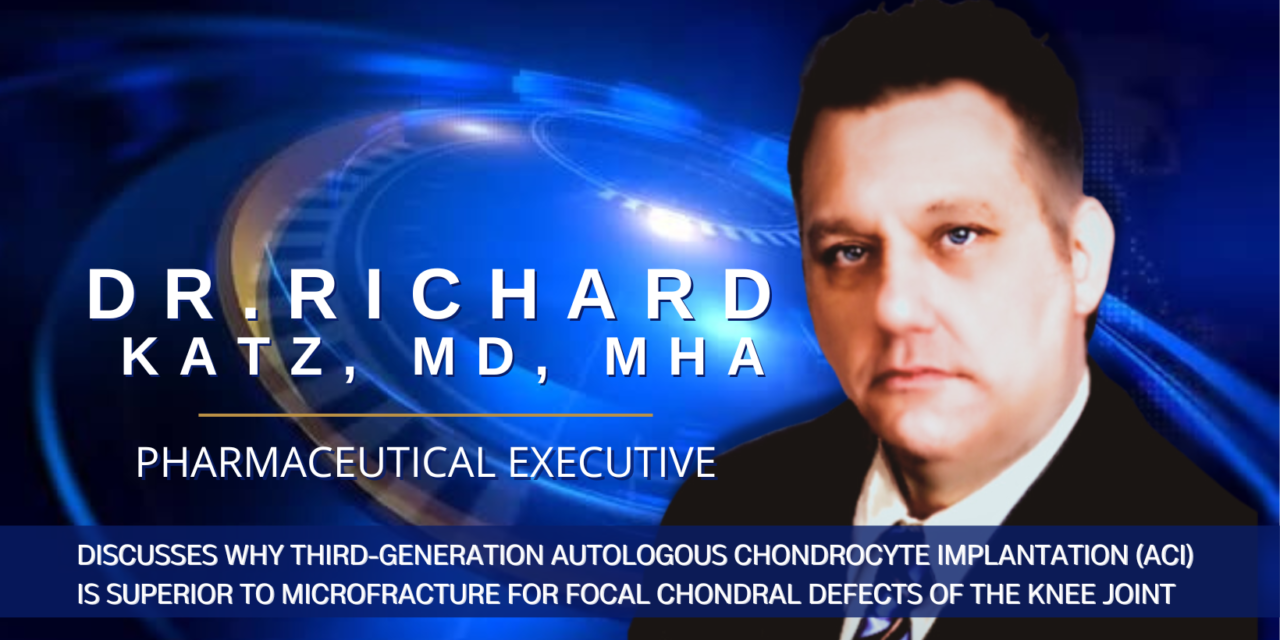Richard Katz, MD, MHA is a pharmaceutical executive with extensive experience in central nervous system, regenerative – biological therapies, clinical trial design and operations. Dr. Katz has consulted across many therapeutic areas in the pharmaceutical and life science industries. His focus is on delivering more effective, affordable, treatments to improve patient health outcomes making a global impact on healthcare than what is possible by treating one patient at a time.
Dr. Richard Katz joins us to discuss why third generation autologous chondrocyte implantation (ACI) is superior to microfracture for focal chondral defects of the knee joint.
Can you first tell us a little about focal chondral defects of the knee joint?
Focal chondral defects of the knee joint refers to localized areas of damage or loss of articular cartilage in the knee. Articular cartilage is the smooth, protective covering that lines the ends of the bones within the joint. It allows for smooth movement and acts as a cushion, reducing friction and absorbing shock during joint motion.
Chondral defects can occur due to various factors, including traumatic injuries, repetitive stress, degenerative conditions, or genetic predisposition. These defects can range in size and depth, from small lesions to larger areas of cartilage damage. The severity of the defect determines the impact on joint function and the potential for symptoms such as pain, swelling, stiffness, and limited range of motion.
Focal chondral defects can be challenging to manage as articular cartilage has limited regenerative capacity. It is a relatively avascular structure, and the dense extracellular matrix located between chondrocytes prevents movement of these cells and nutrients to the defect site. This makes cartilage repair difficult. If left untreated, these defects can progress, leading to further cartilage degeneration, joint instability, and the development of osteoarthritis.
The treatment of focal chondral defects aims to promote cartilage repair and restoration of joint function. Various surgical techniques and interventions are utilized to achieve this goal, including autologous chondrocyte implantation (ACI), microfracture, osteochondral grafting, and other emerging technologies. It is important to address focal chondral defects promptly and effectively to prevent further joint deterioration and to improve the patient’s quality of life. Treatment options continue to evolve with advancements in regenerative medicine, providing hope for enhanced outcomes in the management of these knee joint conditions.
You mentioned some different treatment options. Can you first explain what ACI is?
Autologous chondrocyte implantation, or ACI, is a surgical procedure that involves the transplantation of autologous chondrocytes into the damaged area of the knee joint. The process typically includes three stages: (1) arthroscopy to assess the extent of the chondral defect, (2) harvesting of healthy cartilage cells, and (3) re-implantation of the chondrocytes into the lesion.
There are three generations of ACI:
- 1st generation ACI with a chondrocyte suspension injected under a periosteal flap
- 2nd generation ACI with a chondrocyte suspension injected under a collagen membrane
- 3rd generation ACI with chondrocytes seeded on or in a scaffold
As stated in the National Library of Medicine,
Autologous Chondrocyte Implantation (ACI) is a two-step procedure that has been used clinically in humans since the 1980’s. In the original ACI technique (first-generation technique), the first step consisted of surgically removing small biopsies of normal cartilage from non-weight-bearing areas of the knee. Chondrocytes were then enzymatically isolated from the biopsies, expanded ex vivo in monolayer culture and harvested as a cell suspension several weeks later. In the second step, surgeons injected the cell suspension under a periosteal flap harvested from the proximal medial tibia and previously sutured over the cartilage.
ACI that uses suspended cultured chondrocytes with a covering of collagen type I/III membrane is called a second-generation. The first and second generations of ACI required a longer and more invasive procedure. The earlier ACIs required a surgeon to use a separate membrane to secure new cartilage cells in place over a patient’s cartilage using sutures. This was time consuming and cumbersome for surgeons and caused trauma and scar tissue formation to surrounding tissue.
Third-generation ACI comprises those procedures that deliver autologous cultured chondrocytes using cell carriers or cell-seeded scaffolds. The second and third generation are also known as autologous chondrocyte implantation using collagen membrane-associated autologous chondrocyte implantation, and scaffold-based ACI. These procedures addressed most of the concerns related to the earlier generation ACI. The use of scaffolds to create a cartilage-like tissue in a three-dimensional culture system allows for the optimization of the procedure from both a biological and surgical standpoint.
ACI offers several advantages over other techniques, including the ability to address larger lesions and provide more durable and long-lasting repair.
What are some of the limitations of the microfracture technique?
Microfracture is a minimally invasive procedure that involves the creation of small holes in the subchondral bone to stimulate the release of marrow elements into the defect site. This influx of cells is expected to differentiate into fibrocartilage, thereby filling the chondral defect. However, microfracture has certain limitations that impact its efficacy. Firstly, the regenerated tissue is predominantly fibrocartilage rather than the desired hyaline cartilage, which lacks the biomechanical properties of native articular cartilage. Additionally, the fibrocartilage is prone to degeneration over time, leading to compromised long-term outcomes. Lastly, microfracture is less suitable for larger lesions, as the technique is less effective in generating adequate repair tissue in such cases.
What are some of the benefits of ACI as opposed to microfracture for treating focal chondral defects of the knee joint?
Multiple studies and clinical evidence support the superiority of Autologous Chondrocyte Implantation (ACI) over microfracture for the treatment of focal chondral defects of the knee joint. Some of the key points include–
- Enhanced Cartilage Regeneration: ACI has been shown to promote the formation of hyaline-like cartilage, which closely resembles the native articular surface. In contrast, microfracture primarily yields fibrocartilage, which as already discussed, lacks the biomechanical properties and durability of hyaline cartilage. Several studies have demonstrated the superior quality of cartilage repair achieved with ACI compared to microfracture.
- Improved Clinical Outcomes: Numerous clinical studies have reported better clinical outcomes and patient satisfaction with ACI compared to microfracture. For example, one study compared ACI and microfracture outcomes and found significantly higher clinical scores, improved pain relief, and better patient-reported outcomes in the ACI group. Patients who underwent ACI also had a lower need for subsequent surgical interventions, indicating the durability of the repair achieved by this technique over time.
- Long-term Durability: Long-term follow-up studies have shown the sustained efficacy of ACI in maintaining cartilage repair. One review evaluated the long-term outcomes of ACI and microfracture and concluded that ACI provided superior repair quality and durability for at least 6 years post-surgery. This suggests that ACI offers a more viable long-term solution for patients with focal chondral defects.
- Lesion Size: ACI is generally considered more suitable for treating larger chondral defects, while microfracture may be limited in its effectiveness for larger lesions. Microfracture relies on the migration and differentiation of marrow elements into the defect, which may be less efficient for larger lesions. ACI, on the other hand, allows for the transplantation of a greater number of chondrocytes, facilitating the regeneration of larger areas of damaged cartilage.
- Advancements in ACI Techniques: The introduction of third-generation ACI techniques, such as matrix-assisted ACI or scaffold-based ACI, has further improved the outcomes of ACI procedures. These techniques enhance chondrocyte delivery, cell viability, and integration with the surrounding native cartilage, leading to more successful cartilage repair compared to microfracture.
You have certainly given us some compelling information in support of ACI. Are there other factors a patient or doctor should consider?
It is important to note that individual patient factors, lesion characteristics, post‐operative rehabilitation and surgical expertise also play a role in determining the most suitable treatment approach. However, the cumulative evidence suggests that ACI offers superior outcomes compared to microfracture for focal chondral defects of the knee joint, including enhanced cartilage regeneration, improved clinical outcomes, and long-term durability.












